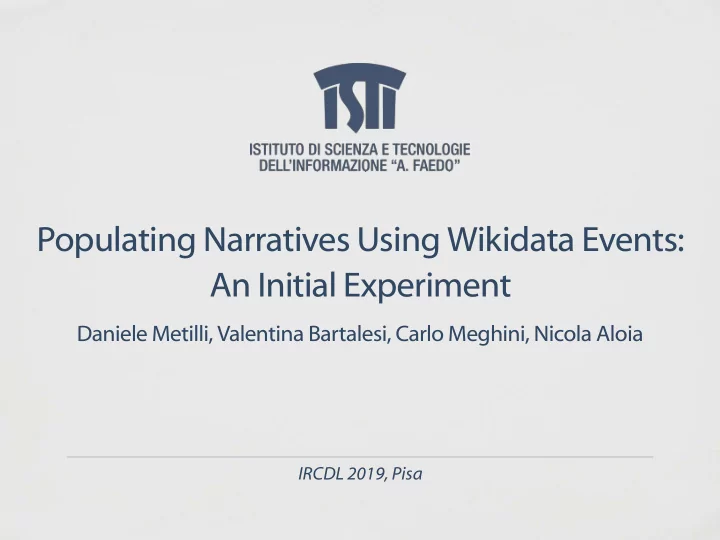

Populating Narratives Using Wikidata Events: An Initial Experiment Daniele Metilli, Valentina Bartalesi, Carlo Meghini, Nicola Aloia IRCDL 2019, Pisa
Narratives in Digital Libraries Our research aims to introduce narratives into Digital Libraries We believe that narratives would allow DLs to provide more sophisticated information services to their users, going beyond the current state
An Ontology for Narratives We have developed a formal ontology to represent narratives • Based on Semantic Web technologies • Built on top of the CIDOC CRM standard ontology • Expressed in OWL We intend a narrative as a network of events defined by a narrator , endowed with factual aspects (who, what, where, when) and semantic relations
Narrative Building and Visualising Tool (NBVT) We have developed a tool to build and visualise narratives (NBVT) • Populates the ontology • Semi-automated, imports knowledge from the Wikidata knowledge base • Four case studies : https://dlnarratives.eu/narratives.html
Integration with Wikidata Wikidata is an open collaborative knowledge base containing more than 54 million entities The user of NBVT is able to import any Wikidata entity into a narrative The narrative can be linked to the much bigger Wikidata graph , and through it to related projects such as Wikipedia and Wikimedia Commons
A Narrative of Dante Alighieri’s Life As case study we built a narrative about Dante Alighieri using NBVT Composed of 53 events describing the life of the poet, each connected to one or more related entities (e.g. people, places, objects…) 69% of these entities are present in Wikidata… but only one event !
Importing Events from Wikidata Wikidata contains more than 100% 54 million entities , but just 3.5% of these are events 75% Other Entities Since Wikidata’s ontology is not event-based , most events are Other 50% Entities represented implicitly 25% Dante Alighieri creator Events Divine Comedy Events 0% Wikidata Our Narratives
Generating the Wikidata Event Graph We generated the Wikidata Event Graph (WEG) containing all events found in Wikidata, both implicit and explicit • We developed an algorithm to identify Wikidata properties that were likely to express events • In this initial experiment we focused on a subset of 50 properties expressing events about people’s lives • We generated an explicit event for each usage of each property (more than 11 million events in total) • We evaluated the results on our narrative about Dante
Wikidata Event Graph – Example creator Dante Alighieri Divine Comedy In Wikidata In the WEG carried out by Dante Alighieri Creation of the has created Divine Comedy Divine Comedy type Creation
Results of the Experiment Before the experiment, only one of the 54 events of our case Not Linked study was explicitly present 40% Events Linked in Wikidata 60% Now, 34 events (60% of the total) can be found in the Wikidata Event Graph Not Linked Similar to the percentage of 31% Related related entities that we had Entities Linked 69% already linked to Wikidata (69%)
Results of the Experiment Number of events (millions) We increased the number of 14 events we can import into our tool by more than 600% 10.5 We started from 1.9 million explicit Wikidata events 7 We added 11.7 million events that were implicit 3.5 We now have access to a graph of 13.6 million events 0 Before After
Conclusions We have presented an experiment on the population of the narrative of the life of Dante Alighieri using the events of the Wikidata Event Graph (WEG) We have generated a subset of the WEG starting from a set of 50 Wikidata properties We have been able to link to the WEG 60% of the events of our narrative about Dante We now have access to a graph of 13.6 million events which we can import into our NBVT tool
Future Works Analyse more properties to extract more events Study how to suggest events from the WEG to the users through the interface our tool Work on narrative extraction from text in natural language
Thank you https://dlnarratives.eu
Recommend
More recommend